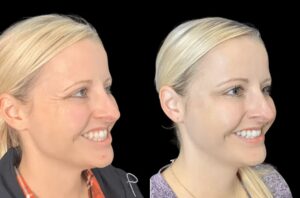
A weak nose bridge can impact the overall symmetry and structure of the face. Whether due to genetics, injury, or aging, a flattened or underdeveloped nasal bridge can make the nose appear less defined or out of balance with other facial features. In such cases, rhinoplasty—commonly known as a nose job—can provide a significant enhancement. This cosmetic procedure reshapes and strengthens the nasal bridge, improving both aesthetics and function. Many individuals seek Rhinoplasty Dubai Silicon Oasis for specialized care and refined results in addressing these concerns. Let’s take a deep dive into how rhinoplasty works to correct a weak nasal bridge and what patients can expect from the process.
Understanding the Anatomy of a Weak Nose Bridge
The nasal bridge is the upper, bony part of the nose that connects the forehead to the rest of the nasal structure. In people with a weak or low nasal bridge, this area appears flatter or less projected, often resulting in:
-
A less defined nose profile
-
Poor facial balance
-
A broader nasal appearance
-
Potential breathing difficulties (if internal structures are affected)
How Rhinoplasty Corrects a Weak Nasal Bridge?
Rhinoplasty for a weak nasal bridge involves augmenting and restructuring the bridge using implants, cartilage grafts, or reshaping the bone. Here’s what typically happens during the procedure:
Consultation and Assessment
The journey begins with a comprehensive facial analysis. Surgeons evaluate nasal structure, symmetry, and facial proportions to customize a plan.
Selection of Graft Material
Depending on the patient’s condition, surgeons may use:
-
Autologous cartilage (from the ear or rib)
-
Silicone or Gore-Tex implants
-
Septal cartilage (if enough is available)
Surgical Technique
-
Incisions are usually made inside the nostrils (closed rhinoplasty) or across the columella (open rhinoplasty).
-
Cartilage or implant is inserted and sculpted to build up the bridge.
-
Tissue is re-draped, and incisions are closed.
Treatment Process: Step-by-Step
Here’s a simplified outline of what to expect throughout the rhinoplasty experience:
| Step | Details |
|---|---|
| Initial Consultation | Detailed nasal evaluation, 3D imaging, and discussion of goals |
| Pre-op Preparation | Medical clearance, medication instructions, and avoidance of smoking/alcohol |
| Day of Surgery | Administered under general anesthesia, procedure lasts 1–3 hours |
| Post-op Recovery | Initial swelling, bruising, splint placed, stitches removed in 1 week |
| Final Results | Swelling gradually subsides, final results visible in 6–12 months |
Key Benefits of Rhinoplasty for Weak Nose Bridge
| Benefit | Description |
|---|---|
| Improved Facial Symmetry | Enhances balance between the nose and other facial features |
| Defined Nasal Contour | Builds up the nasal bridge for a sharper, more elegant profile |
| Boost in Self-Confidence | Patients often report feeling more confident after the procedure |
| Breathing Improvements | Can correct internal structural issues that affect airflow |
| Permanent Results | Once healed, the results are typically long-lasting with minimal maintenance |
Expected Results: Before and After
One of the most gratifying aspects of rhinoplasty is the visible transformation it provides. A previously flat or undefined nose can be elevated and refined, contributing to a more harmonious facial appearance. When the nasal bridge is appropriately enhanced, it can make the tip look lifted, reduce nostril width, and even improve overall symmetry with the jawline and cheeks.
Common Concerns About Nose Bridge Rhinoplasty
Will It Look Natural?
Yes, when performed by experienced surgeons, rhinoplasty treatment enhances your appearance without making the nose look artificial or “done.” The aim is subtle refinement.
Is the Procedure Painful?
Discomfort is manageable and mostly experienced during the first few days. Pain relievers and ice packs help reduce swelling and ease the healing process.
How Long Does It Take to Recover?
Most visible bruising subsides in 7–10 days. While you’ll notice early improvements soon after surgery, final outcomes may take several months as internal healing progresses.
FAQ’s:
Can a weak nose bridge be corrected without surgery?
Non-surgical rhinoplasty (using dermal fillers) may offer temporary enhancement, but it does not provide permanent or structural correction like surgical rhinoplasty.
Will there be visible scars?
If an open technique is used, a small scar may form at the columella (between the nostrils), but it usually fades significantly. Closed techniques leave no external scars.
Are the results permanent?
Yes. Once healed, the results are stable and long-lasting unless further trauma or injury occurs.
Is rhinoplasty only cosmetic?
No. Rhinoplasty can also address functional issues such as deviated septum, breathing difficulties, or prior injury correction, in addition to aesthetic enhancement.
How long before I can resume physical activities?
Light activities can resume after 1–2 weeks. However, strenuous exercise or contact sports should be avoided for 4–6 weeks to protect the healing nose.
Final Thoughts
A weak nose bridge can subtly impact facial harmony and self-perception. Fortunately, rhinoplasty offers a tailored solution to enhance structure, function, and confidence. By building and sculpting the nasal bridge, the procedure can bring dramatic yet natural-looking changes.

